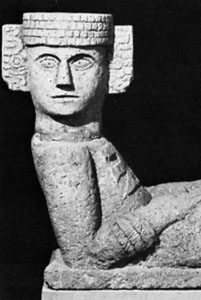
Calvino’s Mr. Palomar, “Serpents and skulls.” Mr Palomar is getting a tour of Toltec city of Tula from a knowledgable local scholar who goes deep into the mythos, symbolism, and network of associations. But they interrupted by a schoolteacher telling his students a simpler story.
The line of schoolboys passes. And the teacher is saying, “Esto es un chac-mool. No se sabe lo que quiere decir.” (“This is a chac-mool. We don’t know what it means.”) And he moves on.
Though Mr. Palomar continues to follow the explanation of his friend acting as guide, he always ends up crossing the path of the schoolboy and overhearing the teacher’s words. He is fascinated by his friends’s wealth of mythological references: the play of interpretation and allegorical reading has always seemed to him a supreme exercise of the mind. But he feels attracted also by the opposite attitude of the schoolteacher: what had at first seemed only a brisk lack of interest is being revealed to him as a scholarly and pedagogical position, a methodological choice by this serious and conscientious young man, a rule from which he will not serve. A stone, a figure, a sign, a word reaching us isolated from its context is only that stone, figure, sign, or word: we can try to define them, to describe them as they are, and no more than that; whether, beside the face they show us, they also have a hidden face, is not for us to know. The refusal to comprehend more than what the stones show us is perhaps the only way to evince respect for their secret; trying to guess is a presumption, a betrayal of that true, lost meaning.


